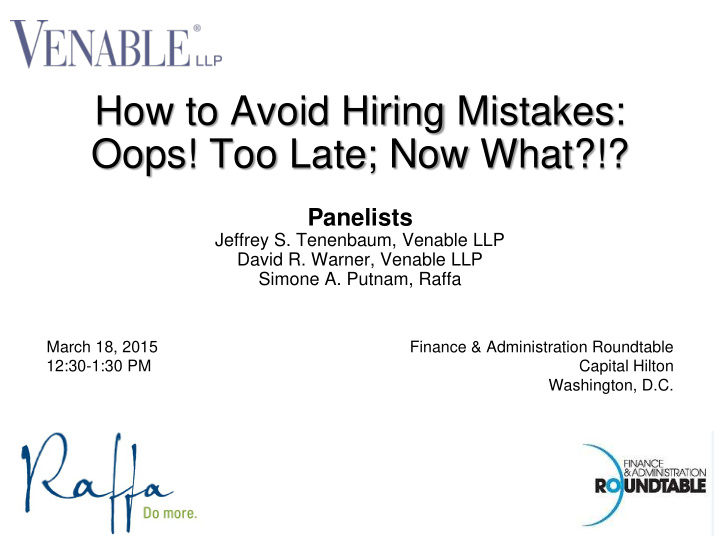



How to Avoid Hiring Mistakes: Oops! Too Late; Now What?!? Panelists Jeffrey S. Tenenbaum, Venable LLP David R. Warner, Venable LLP Simone A. Putnam, Raffa March 18, 2015 Finance & Administration Roundtable 12:30-1:30 PM Capital Hilton Washington, D.C. 1
Agenda Overview of employment relationship Legal framework for effective hiring and defensible firing Practical considerations for effective hiring Principles of performance management and discipline Q&A 2
Employment Relationship Basic Rule: Employment Relationship is “at will” – either party may end relationship for any or no reason Basic Rule is riddled with exceptions – Statutory, Contractual, Public Policy 3
Employment Contracts Express Contract – Limits ability to terminate relationship – Usually provides for a just cause or good cause firing May arise by implication – Handbook or manual – Application or offer letter – Oral statements 4
Employment Laws Title VII ADA ADEA FMLA GINA DCHRA 5
Hiring the Right Person, Legally Why hire the right person? – Need to get the job done – Avoid the time and expense of training the wrong person – Avoid expense and anguish of terminating a wrong hire – Avoid litigation 6
Overview – Sourcing and Vetting Candidates Applications Interviews – It is presumed that you use the information that you ask for – Therefore, only ask for information you need and will use Background Checks – “Ban the box” Wait, what are we missing here …? 7
Recruitment – Challenges to Best Practices Not knowing where to recruit Sole reliance on informal networks or word- of-mouth Failing to advertise widely, including in targeted fashion to diverse groups Failure to use posting and recruiting systems once developed 8
Recruitment – Best Practices Recruitment policy and procedures – Structured process – Responsible individuals – Training – Establish and communicate basic qualifications and essential job functions for each job – Use of internal and external job posting systems • Comprehensive and consistent job posting 9
Selection – Challenges to Best Practices Use of non-validated tools – Or use of no tools at all Overuse of subjective criteria “Like me” selections Stereotyping Absence of documentation Lack of formalized process for feedback Ignorance 10
Selection – Best Practices Recruitment policy and procedures – Responsible individuals – Established selection criteria Established interview questions – Derived from job analyses – Or at least derived from position description Structured interviews Objective rating scales “anchored” with exemplar responses Multiple and diverse interviewers or panel interviews Interviewer training 11
Selection – Communication Avoiding a process that provides no feedback Initial communications should confirm posting and set expectations – “This position will remain open for __ days” – “You are one of __ candidates posting for this position” Communication of status should be timely, particularly to unsuccessful candidates For internal candidates interviewed, guidance for career development should be provided 12
Selection – Avoiding Common Errors Disability bias – Have you ever been hospitalized? – Have you ever received workers comp? Age bias – Date of birth – Year of completing degrees Gender/marital status – What does your spouse do? – Do you have children? Financial status – Do you own your home? – How will you commute? 13
Selection – Record Maintenance Beyond disposition codes – Lists of interview participants – Questions utilized – Interview notes – Scores and other data Should be able to recreate decision-making process 14
Mistakes Were Made – Lawfully Disciplining and Discharging Employees Reducing the chance of claims – Documenting performance issues – Consistency Implementation – Communication – Ensuring fairness and proportionality 15
Reducing the Chance of Claims Accurate records and consistent enforcement of clearly communicated rules are best “defense” to potential charges Consistency in practices – Key is treating similarly situated employees alike, with supporting documentation – Follow written policies 16
Reducing the Chance of Claims Documentation is key, even with new hires – Performance: Ensure accurate, honest appraisals – Discipline: Contemporaneous records are more credible – Ensure “legal” reasons • Review documentation prior to implementation 17
Factors in Implementing Discipline Consistency – Legal as well as employee relations significance Proportionality Fairness and perception of fairness 18
Communication Counsel employee regarding violation – Identify violation – Identify expected future conduct and the consequences of future violations – If probation, identify length, terms, consequences – Instructions regarding confidentiality and retaliation – Document, Document 19
Demonstrating a Believable Basis for Discipline/Discharge Did the employee have notice of the rules? Was the rule or directive violated a reasonable one? Was there a fair investigation? Was there proof of a violation? Was the penalty reasonable ? Was there equal treatment – consistency ? 20
Contact Information Presenters Jeffrey S. Tenenbaum Simone A. Putnam jstenenbaum@Venable.com sputnam@raffa.com t 202.344.8138 t 202.855.6770 David R. Warner drwarner@Venable.com t 703.760.1652 www.Venable.com 21
Recommend
More recommend